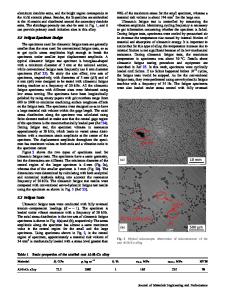Characteristics of elastic waves generated by crack initiation in aluminum alloys under fatigue loading
- PDF / 361,601 Bytes
- 7 Pages / 612 x 792 pts (letter) Page_size
- 72 Downloads / 384 Views
Ajit Mal Mechanical and Aerospace Engineering Department, University of California, Los Angeles, California 90095 (Received 31 July 2000; accepted 26 March 2001)
The characteristics of elastic waves emanating from crack initiation in 2024 and 5052 aluminum alloys subject to static and fatigue loading were investigated through laboratory experiments. The objective of the study was to determine the differences in the properties of the signals generated from static and fatigue tests and also to examine if the sources of the waves could be identified from the temporal and spectral characteristics of the acoustic emission waveforms. The signals were recorded using nonresonant, flat, broadband transducers attached to the surface of the alloy specimens. The time dependence and power spectra of the signals recorded during the tests were examined and classified according to their special features. Three distinct types of signals were observed. The waveforms and their power spectra were found to be dependent on the material and the type of fracture associated with the signals. Analysis of the waveforms indicated that some signals could be attributed to plastic deformation associated with static tests. The potential application of the approach in health monitoring of aging aircraft structures using a network of surface mounted broadband sensors is discussed.
I. INTRODUCTION
An increasing number of civil as well as military aircraft are being required to remain in service well beyond their design life of approximately 20–25 years. All such “aging aircraft” are likely to sustain internal damage due to corrosion and fatigue. Corrosion usually occurs when the aircraft is on the ground and fatigue is associated with pressurization/depressurization cycles during flight. Fatigue results in the initiation and growth of cracks at stress concentration points and the presence of a corrosive environment exacerbates this process. Corrosion damage to critical parts of an aircraft, if undetected, can be extremely costly with the risk of loss of life as well as hardware in case of catastrophic failure. Continuous inspection and condition-based maintenance of aging aircraft components degraded by corrosion and fatigue are key elements in the safe and cost-effective life extension programs of aging aircraft.1 Acoustic emission (AE) is a nondestructive methodology that has been used, with varying degrees of success, to monitor damage evolution in structures subject to service loads. In conventional AE analysis, parameters such as events-count, distribution of signal amplitude, signal rise time, and the RMS energy of the signals have been J. Mater. Res., Vol. 16, No. 6, Jun 2001
http://journals.cambridge.org
Downloaded: 16 Mar 2015
used to establish empirical relationships between these parameters and damage to the material.2– 4 Numerous empirical studies have been conducted to examine the correlation between the AE signals and fracture and fatigue damage parameters in a variety of materials. It has been shown that under static loading AE
Data Loading...











